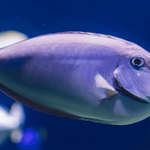The epipelagic zone is the uppermost part of the ocean, extending from the surface to about 200 meters deep. Sunlight penetrates this layer, allowing phytoplankton and other organisms to produce oxygen through photosynthesis. This makes the epipelagic zone incredibly important – over half of the world’s oxygen is made here!
A diversity of marine life relies on the epipelagic zone, including fish, mammals, sea turtles, and seabirds. It’s full of food and life. But human activities like pollution, overfishing, and climate change threaten this critical environment and the animals that depend on it. Protecting the epipelagic zone is key to having healthy oceans that support abundant biodiversity.
The animals that live in this illuminated surface layer give us oxygen, food, and wonder – we must be dedicated stewards.
Key Takeaways:
- The epipelagic zone from the surface to 200 meters deep contains a spectacular abundance and diversity of marine life like fish, mammals, plankton, seabirds and more
- Phytoplankton and zooplankton are microscopic drifters that form the vital base of oceanic food webs
- Threatened top predators like tuna, billfish and sharks hunt amidst jellyfish swarms and Sargassum rafts in the rich epipelagic layer
- Whales, dolphins and sea turtles traverse trophic-rich epipelagic waters, but face substantial threats from human activity
- Preserving this vulnerable yet productive realm through pollution control and sustainable fishing is key to maintaining healthy global fisheries
List of Animals in the Epipelagic Zone
Quick Answer: The epipelagic zone extending down 200 meters hosts a spectacular diversity of marine life like whales, seabirds, fish, sea turtles, sharks, jellyfish, and plankton, drifting and hunting amidst algal blooms and floating forests while facing threats from human impacts below.
| Category | Details |
| Phytoplankton | Foundation of the marine food web, generating over half of Earth’s oxygen. Main types include diatoms and dinoflagellates. |
| Zooplankton | Diverse organisms including copepods and krill, serving as a critical link in the marine food chain. |
| Jellyfish | Include species like moon jellies and lion’s mane jellyfish, known for their stunning appearance and role in the ecosystem. |
| Fish | Home to various species including tuna and sharks, acting as apex predators in the marine food web. |
| Marine Mammals | Includes dolphins and whales, known for their intelligence and complex social behaviors. |
| Invertebrates | Hosts species like squid, octopuses, and Sargassum algae, each playing unique roles in the ecosystem. |
| Unique Adaptations | Features species with special adaptations like countershading and bioluminescence, aiding in survival and predation. |
1. Phytoplankton: The Foundation of the Food Web
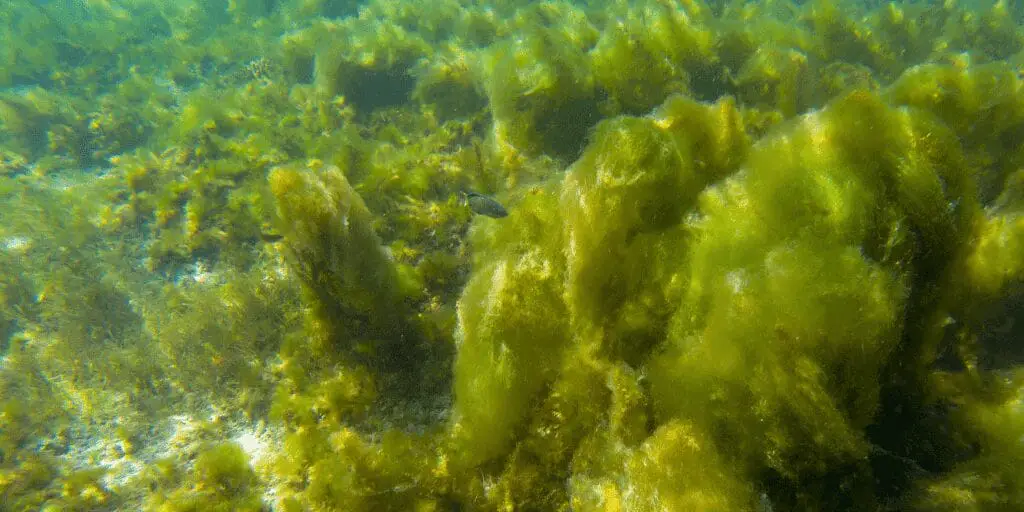
Phytoplankton are microscopic organisms that form the base of the marine food web in the epipelagic zone, the uppermost layer of the ocean extending down to 200 meters. As primary producers, phytoplankton convert sunlight and carbon dioxide into organic matter and oxygen through photosynthesis. There are two main groups of phytoplankton that thrive in the well-lit epipelagic zone – diatoms and dinoflagellates.
Types of Phytoplankton
Diatoms are single-celled algae encased in elegant glass-like cell walls made of silica. There are over 100,000 species of diatoms, coming in a variety of shapes and sizes. Dinoflagellates are another large group of single-celled phytoplankton. Many dinoflagellates have two flagella that allow them to propel through the water.
Some also produce light through bioluminescence. Dinoflagellates are associated with harmful algal blooms known as red tides. Both diatoms and dinoflagellates are critical parts of the marine food chain.
Ecological Role and Importance
As primary producers, phytoplankton provide the foundation for the entire marine ecosystem. Through photosynthesis, phytoplankton generate over half of the oxygen in Earth’s atmosphere while also sequestering significant amounts of carbon dioxide from the environment. As such, these microscopic workhorses greatly impact global climate patterns.
Phytoplankton also nourish a variety of organisms including small fish, shrimp, and baleen whales. A decline in phytoplankton productivity would reverberate through the food web. Maintaining healthy phytoplankton populations is therefore critical for the health of Earth’s oceans and life that depends on it.
2. Zooplankton: The Prolific Drifters
Zooplankton are a diverse collection of tiny drifting animals that inhabit the epipelagic zone. Ranging in size from microscopic to several centimeters long, these organisms float within the upper 200 meters of the ocean. As prolific secondary producers, zooplankton serve a critical ecological role in marine food webs. They feed on phytoplankton and in turn become food for numerous species of fish, whales, seabirds, and other predators.
Varieties of Zooplankton
There are thousands of zooplankton species, but some of the most important in the epipelagic zone are copepods and krill. Copepods are exceptionally abundant crustaceans, with some species growing up to 2 mm in length. Krill are shrimp-like creatures that can reach 6 cm as adults and commonly form dense swarms called krill patches.
Both copepods and krill exhibit vertical migration, moving down to deeper waters during the day and rising up at night to feed. Their adaptations allow them to thrive amidst the challenges of drifting within the dynamic epipelagic zone.
Role in the Marine Food Web
As primary and secondary consumers, phytoplankton and zooplankton form the foundation of marine food chains. Zooplankton graze on phytoplankton, transferring that energy and nutrients to larger marine life. For instance, baleen whales feast on dense krill swarms while copepods sustain small schooling fish.
Many seabirds also directly consume zooplankton like krill. Additionally, some zooplankton migrate from the epipelagic zone down to the twilight zone below, transporting nutrients between layers and benefiting deep-sea ecosystems. Zooplankton may be small, but their ecological influence is mighty.
3. Jellyfish: The Floating Spectacles
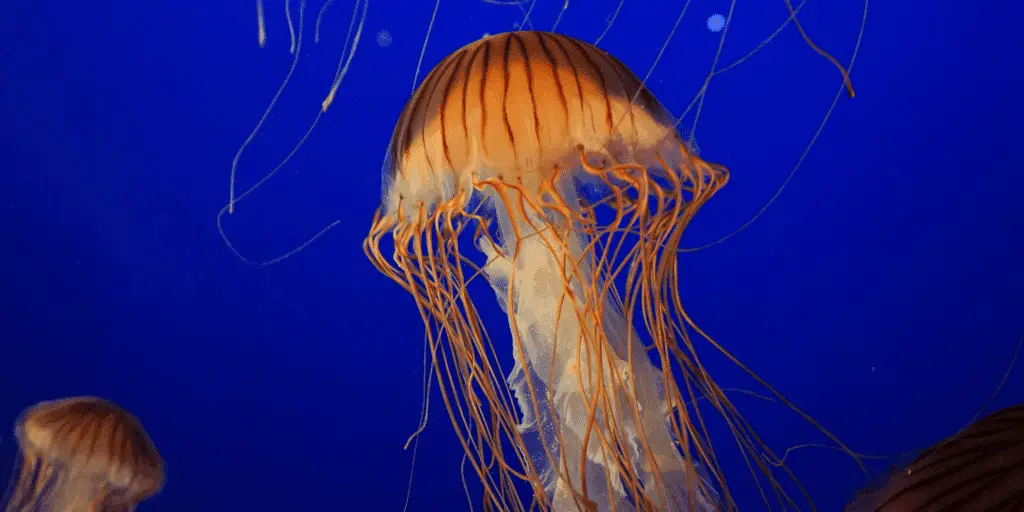
Jellyfish are visually stunning inhabitants of the epipelagic zone. With their translucent bell-shaped bodies and flowing tentacles, these gelatinous zooplankton drift through the illuminated surface waters feeding on fish eggs, larvae and other tiny prey. Jellyfish come in a spectacular array of shapes, sizes and colors.
Of the over 2000 jellyfish species, scyphozoan jellyfish are most common in the epipelagic zone. These include moon jellies with their delicate rounded bells and fierce lion’s mane jellies trailing their deadly trailing tentacles behind them.
Diversity of Jellyfish Species
Some of the most frequently spotted jellyfish in the epipelagic zone are Aurelia aurita (moon jellies), Cyanea capillata (lion’s mane jellyfish), and Physalia physalis (Portuguese man o’ war). Moon jellies have short tentacles and a mild sting making them popular in aquariums.
Lion’s mane jellies are renowned for their fiery sting courtesy of the nematocysts covering their long tentacles. Despite its name, the Portuguese man o’ war is not a single jellyfish but a colonial hydrozoan with multiple polyps working together almost like a “super-organism.”
Adaptations and Survival Strategies
Jellyfish have unique adaptations allowing them to drift with ease in the gently churning waters of the epipelagic zone. Their bell structures expand and contract to propel them forward while their stinging tentacles help capture prey. Some jellyfish can even regenerate lost body parts.
Jellyfish go through a complex life cycle, often with both polyp and medusa stages. Their ability to reproduce rapidly helps them bloom into large swarms when conditions are favorable, allowing them to temporarily dominate local marine ecosystems. Some species also harbor symbiotic microalgae for extra nutrition through photosynthesis.
4. Tuna: The Speedy Predators
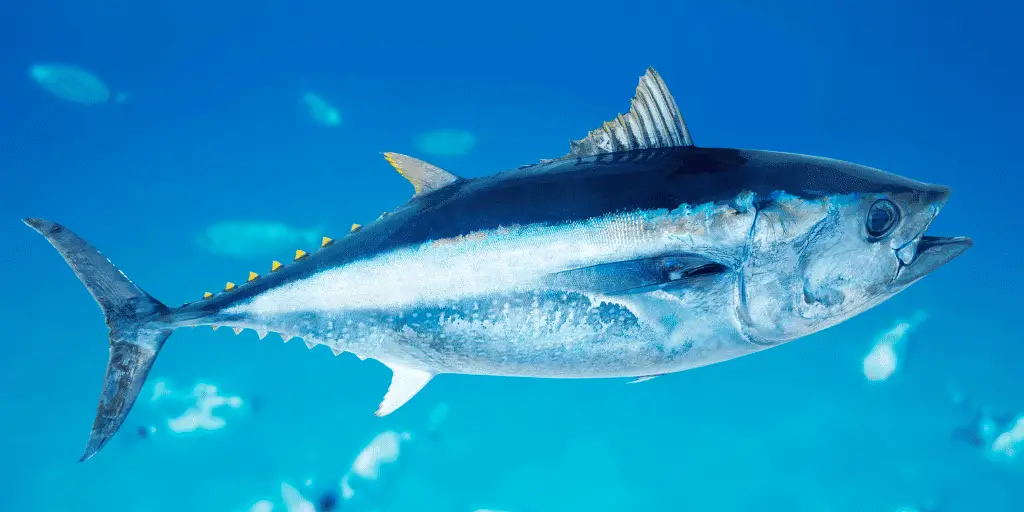
Tuna are large, swift predatory fish perfectly adapted to life in the epipelagic zone. With torpedo-shaped bodies, powerful crescent-shaped tails, and specialized fins, tuna can propel themselves at remarkable speeds to catch prey. Tunas are regional migrants that undertake long journeys across oceans to feed and reproduce. Several tuna species reside in or frequently visit the nutrient-rich epipelagic zone.
Types of Tuna in the Epipelagic Zone
Some tunas commonly found hunting smaller fish and squid in the epipelagic zone are: albacore tuna (Thunnus alalunga), yellowfin tuna (Thunnus albacares), bigeye tuna (Thunnus obesus), bluefin tuna (Thunnus thynnus), and skipjack tuna (Katsuwonus pelamis).
Albacore and yellowfin have an average length of around 1 meter while tropical bigeye and prized Pacific bluefin can grow over 2 meters long. These powerful swimmers all have similar streamlined shapes but vary in exact features and migratory patterns.
Ecological Impact and Conservation
As apex ocean predators, tuna play a vital role in the epipelagic marine food web. However, many tuna species have experienced significant population declines due to overfishing and bycatch. Global tuna catches peaked in 2006 at over 7 million tonnes before declining.
Rebuilding sustainable global tuna stocks is crucial for the long-term health of marine ecosystems. International management organizations now work to collect population data and enforce catch quotas and fishing regulations to conserve these commercially and ecologically important fish.
5. Sharks: The Apex Predators
Sharks are formidable ocean hunters who dwell in or pass through the epipelagic zone. As apex predators, sharks play a vital role in maintaining balance in the marine ecosystem by feeding on weak, injured, or diseased prey. Over 500 shark species have been identified globally, some of which inhabit the sunlit epipelagic waters.
Species Diversity of Epipelagic Sharks
Several shark species dwell in or frequently visit the nutrient-rich epipelagic zone to hunt. These include the formidable great white shark, hammerheads with their unique cephalofoil heads, gentle giant whale sharks, and swift mako sharks that can leap over 9 meters out of the water.
These diverse predators may vary in size, features, and feeding habits, but all sharks found here share similar streamlined bodies and heightened sensory systems to catch swift prey.
Conservation Challenges and Efforts
Many sharks face substantial population pressures today due to overfishing for fins and meat along with accidental bycatch issues. However, there is hope. Established marine preserves provide sanctuaries while international restrictions on finning and fishing quotas aid in sustaining numbers.
Further advancing public awareness of the ecological role sharks play can support ongoing conservation efforts. Safeguarding shark populations contributes to the overall stability of ocean life in the epipelagic zone and beyond.
6. Dolphins and Whales: The Mammalian Inhabitants
Dolphins and whales are highly intelligent marine mammals that frequent the epipelagic zone. These species travel in pods, communicating intricately and demonstrating complex social bonds.
Several dolphin species and baleen whales inhabit or migrate through areas rich with fish and plankton prey. Their presence reflects the bountiful biodiversity found in the illuminated surface layer.
Diversity of Dolphin and Whale Species
A number of dolphin species, like common bottlenose dolphins, spotted dolphins, and striped dolphins commonly socialize and hunt in epipelagic waters near continental shelves and islands. Various large whales also frequent this zone during annual migrations.
These include energetic humpback whales performing their cryptic songs, enormous yet gentle blue whales skimming for krill, and prominent grey whales migrating incredible distances between feeding and breeding grounds.
Threats and Conservation Measures
While visually resplendent, the epipelagic zone’s biodiversity faces substantial human impacts. Pollution, fishing gear entanglements, ship strikes, and noise disruption threaten dolphins and whales alike. International conservation measures aim to reduce these pressures.
For instance, universal whaling bans provide respite for recovering populations. Continued habitat protections and responsible whale-watching tourism help safeguard these emotive creatures for generations to come. Maintaining the health of the epipelagic zone ultimately supports the survival of these intelligent marine mammals.
7. Billfishes: The Long-Bodied Hunters
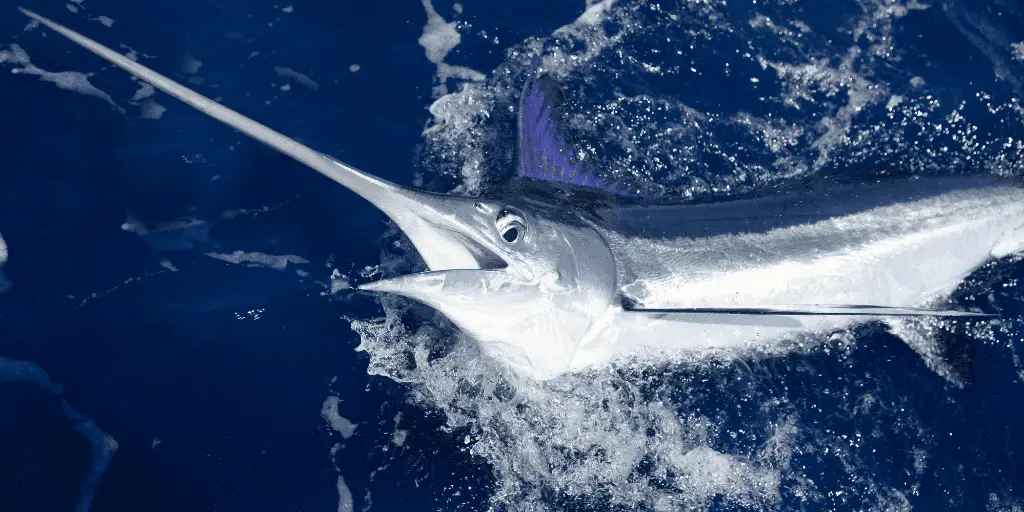
Billfishes are a group of large, predatory fish equipped with extended, spear-like bills that aid in swiftly catching prey. Several billfish species inhabit or migrate through the epipelagic zone to hunt smaller tuna, mackerel, and squid in the enriched surface waters. Their elongated bodies, powerful tails, and high speed make them effective hunters.
Species of Billfish in the Epipelagic Zone
Billfish found hunting in the epipelagic zone include sailfish (Istiophorus platypterus), blue marlin (Makaira nigricans), black marlin (Istiompax indica), and swordfish (Xiphias gladius). Sailfish reach speeds of 110 km/hr using their large dorsal fins to corral fish into compact balls for easy feeding.
Heavier blue marlins and black marlins grow over 5 meters in length and can weigh over 700 kg. Swordfish are named for their signature flat, sword-like bills which can reach over 1 meter long in large adults.
Ecological Role and Conservation Issues
As apex predators, billfish control prey population sizes in the epipelagic zone, maintaining balance in the ecosystem. However, many billfish species have undergone concerning population declines from overfishing driven by demand for their meat and reputation as fierce sport fishing competitors. Bycatch in commercial fishing gear also threatens numbers.
Ongoing catch limits, gear modifications, and public education initiatives focused on sustainable fishing practices aid in conserving billfish numbers and support the productive marine food webs they regulate.
8. Seabirds: The Aerial Visitors
Seabirds are a diverse group of birds that interact with the epipelagic zone by soaring, plunging, and floating through the air above it. Seabirds frequent coastal areas, islands, and the open ocean, where enriched surface waters offer abundant food sources and places to rest. Species like gulls, terns, petrels, boobies, frigatebirds, and albatrosses all utilize the resources found in the top pelagic layer during their long-ranging forays out to sea.
Types of Seabirds in the Epipelagic Zone
Many seabirds are specially adapted for exploiting the epipelagic zone. Large albatross and frigatebird species use their long, narrow wings to glide just above the water surface for miles with barely a flap. Opportunistic gulls follow fishing vessels to scavenge discards and prey on surface schooling fish pushed up by tuna and marine mammals.
Swift terns and boobies execute aerodynamic plunges to grab small squid and fish. Resident island birds and migratory open ocean species alike depend on the productivity occurring in the illuminated zone near the surface.
Conservation Challenges and Efforts
As primarily aerial species, seabirds face substantial threats from pollution, habitat loss on nesting islands, poorly regulated fisheries, invasive predators, and extreme weather influenced by climate change.
Global protection efforts aimed at preserving seabird populations focus on reducing pollution, restricting detrimental fishing gear, designating marine preserves, and restoring remote island habitats essential for breeding colonies to thrive. Safeguarding seabird numbers can serve as an indicator of overall ocean health.
9. Squid and Octopuses: The Cephalopod Residents
Squid and octopuses are marine mollusks that inhabit the epipelagic zone, using their flexible bodies and clever adaptations to thrive in the highly productive surface layer. Squid species like Humboldt squid and opalescent squid are characterized by torpedo-shaped mantles, triangular fins, and arms lined with suckers to catch prey.
Octopuses found here, including the common octopus and night octopus, take on more globular shapes along with excellent sight and camouflage capabilities.
Diversity of Squid and Octopus Species
A variety of squid and octopus species occupy ecological niches throughout the epipelagic zone. They range considerably in size from giant and colossal squids reaching 18 meters in length to tiny pygmies under 5 cm long.
Squids often have eight arms and two longer feeding tentacles while most octopuses possess eight arms only. However, both travel by jet propulsion and demonstrate impressive camouflage abilities, blending their skin textures and color rapidly using specialized pigment cells in their skin.
Ecological Importance and Threats
Squid and octopuses play vital ecological roles in the epipelagic zone as both predator and prey. Unfortunately, many populations face great pressure today from overfishing driven by the global demand for their meat. Habitat degradation from pollution and ocean acidification also threaten their numbers and ability to camouflage effectively.
Sustained conservation efforts promoting sustainable fisheries and water quality standards help safeguard the future of these exceptionally adapted cephalopods in the marine ecosystem.
10. Flying Fish: The Gliders of the Ocean

Flying fish are aptly named for their ability to break the surface tension of the water and glide gracefully through the air using specially adapted fin shapes and movements. These remarkable fish are found across warm ocean waters, sheltering in the rich epipelagic zone where they find ample plankton food sources. Periodically taking flight allows them to migrate rapidly and escape predators prowling the waters below.
Species of Flying Fish in the Epipelagic Zone
There are over 60 identified species of flying fish found across the world’s oceans. In the epipelagic zone, some commonly gliding fish are the four-winged flying fish, the Pacific flying fish, and the Indian flying barracuda.
Their enlarged, wing-like pectoral fins, flattened bodies, and powerful tails provide lift and propulsion to skim the water’s surface for extended flights up to 45 seconds long. Some species even glide in synchrony, moving together in graceful harmony through the air.
Adaptations and Survival Strategies
The epipelagic zone’s complex predator-prey dynamics have led flying fish to evolve their distinctive gliding adaptations as an innovative survival strategy. Taking to the air allows quick evasion from predators like tuna, billfish, and dolphins patrolling the waters below. Their streamlined bodies, extensive fins, and ability to change angle and direction during flight enable remarkable aerial agility and distance.
By night they return to the relative safety of the nutrient-rich surface layer to feed, exploiting the zone’s abundant resources and finding refuge until taking flight once more with the morning light.
11. Sea Turtles: The Gentle Giants
Sea turtles are graceful reptiles that inhabit warm ocean waters, including the plentiful epipelagic zone. As hatchlings emerge from sandy nesting beaches, they swim out to drift and feed amongst plankton-rich areas offshore. Several sea turtle species, like green and hawksbill turtles, rely on the productive epipelagic layer early in their life cycles before migrating long distances between nesting and feeding grounds.
Species of Sea Turtles in the Epipelagic Zone
Young sea turtles frequent the food-abundant epipelagic waters, including loggerhead turtles, olive ridley turtles, and Kemp’s ridley turtles. There they feast on jellyfish, sponges, mollusks, and other soft-bodied creatures until large enough to handle bigger prey.
The epipelagic zone offers small juvenile turtles shelter and slow currents to rest in while also bringing the risk of encountering marine debris and predators. Still, some massive leatherback turtles stay to feed almost exclusively on nutrient-rich jellyfish swarms floating in these surface waters for nearly their entire lives.
Conservation Challenges and Efforts
Many sea turtle species face population declines from human activities like coastal development, plastic pollution, illegal harvesting, and fisheries bycatch. However, concerted conservation efforts focused on beach protection, fishing regulations, rehabilitation programs, public education, and international treaties work to preserve sea turtle species.
Maintaining clean, safe epipelagic habitats and migration corridors continues to be vital for securing the future of these ancient mariners.
12. Sargassum: The Floating Forests
Sargassum is a genus of brown algae that forms unique floating habitats in the epipelagic zone. Mats of Sargassum provide shelter, nurseries, and feeding grounds for marine life where little other cover exists in the open ocean.
Fish, crabs, shrimp, and more take refuge amongst drifting Sargassum rafts while young sea turtles hide from predators in the tangled masses. Frigatebirds and other seabirds often rest atop floating Sargassum islands miles from land.
Ecological Role of Sargassum
Drifting masses of Sargassum algae nourish entire marine communities in the nutrient-poor open waters of the epipelagic zone. The algae itself also grows extensively via vegetative propagation in warm waters, creating chain-like floating forests enriched with oxygen, food sources, and cover.
Numerous animals graze directly on the algae while Sargassum’s complex structure hosts dense populations of copepods, isopods, mollusks and other microfauna that sustain food webs reaching up to top predators like Mahi Mahi, billfish, and tuna.
Challenges and Impacts of Sargassum Blooms
Increasing nutrient pollution washing out from rivers coupled with warming equatorial waters has led to rampant Sargassum overgrowth in recent years, causing massive blooms and piles of decaying algae washing up on certain coastlines.
While damaging to local tourism and environments, most pelagic Sargassum still support productive marine oases out in the open ocean.
Further research helps better understand conditions driving extreme blooms and guide management efforts focused on reducing land-based nutrient runoff.
13. Countershading: A Common Camouflage Technique
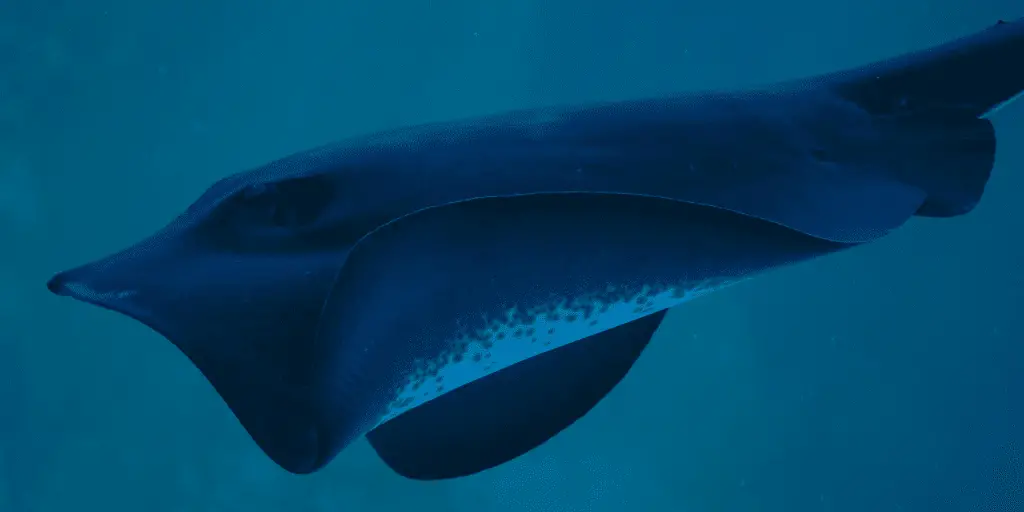
Countershading is a natural camouflage technique exhibited by many marine species living in the sunny surface waters of the epipelagic zone. It involves having darker pigmentation on the topside and lighter coloring on the underside of an animal. This helps disguise shape and shadows, effectively concealing animals from predators and prey.
Examples of Countershading in Marine Species
Countershading is used by many predatory fish that strike from below like sharks, as well as smaller bait fish which blend in from above. The great white shark, for example, relies on countershading to remain invisible when approaching prey against light streaming down from the ocean’s surface.
Species like mackerel and herring have darker backs and silvery bellies, obscuring their outline when viewed from below. Even some cephalopods like squid demonstrate adjustable counter illumination patterns to seamlessly match their surroundings.
Evolutionary and Ecological Significance
The prevalence of countershading among epipelagic marine life underscores its evolutionary importance as an adaptive camouflage strategy. Differing coloration on an organism’s dorsal and ventral surface helps conceal recognizable features, providing critical advantages in detecting prey and eluding danger within a habitat.
The widespread embrace of countershading across species illustrates nature’s intricate methods of perfecting survival in even the most exposed pelagic settings.
14. Bioluminescence: A Light in the Dark
Bioluminescence is the magical production of light by living organisms through a specialized chemical reaction. In the dark depths of the epipelagic zone, some unique species have evolved to glow and illuminate their aquatic world. Bioluminescence helps various organisms find food, defend against predators, and communicate amongst their own kind in the ocean’s dimly lit waters.
Species Exhibiting Bioluminescence
A variety of fish, jellyfish, squid, shrimp, plankton, and more showcase bioluminescence naturally in their ocean habitats. Tiny microscopic plankton like dinoflagellates glow when disturbed. Flashlight fish harbor glowing bioluminescent bacteria near their eyes.
Some jellies and squids produce living lights for stunning defensive displays or alluring lures to catch prey. Together, their luminous blues, greens and yellows put on dazzling undersea light shows.
The Role of Bioluminescence in Marine Ecosystems
While a visual spectacle, bioluminescence serves critical ecological roles in obscure ocean areas where sunlight rapidly fades. Flashing lights help confuse predators, attract mates, or act as beacons between members of the same species. Scientists also research marine bioluminescence for deeper insights into undersea processes and for use in novel applications from environmental monitoring tools to medical treatments.
Continued conservation of delicate bioluminescent organisms is key for sustaining both healthy marine habitats and inspiration for future discoveries.
Human Impact: The Threats to Epipelagic Life
The vibrant diversity of marine organisms living in the sunlit epipelagic zone faces escalating threats from human activities. Pollution, overfishing, climate change disturbances, and more jeopardize the critical balance sustaining productive fisheries and resilience across delicate aquatic food webs interconnected in the epipelagic layer.
Pollution and Climate Change Effects
Nutrient runoff from agricultural waste and sewage stimulates algal blooms while chemicals and plastics accumulate in marine organisms. Ocean warming and acidification degrade habitats, alter species distribution, bleach reefs, and disrupt complex reproductive cycles. Sealife from tiny plankton to reef ecosystems exhibit cascading declines underscoring the need for fast pollution regulation and emissions reductions.
Overfishing and Conservation Efforts
Advancing technology coupled with soaring seafood demand has accelerated commercial overfishing across three quarters of marine environments. Yet sustainable fishing practices, marine preserves, and policies limiting excessive catch help maintain thriving wildlife populations.
Recent conservation efforts benefiting depleted predators like tuna and billfish illustrate that, if guided responsibly, marine biodiversity can rebound. Preserving intact, fully functioning marine ecosystems hinges on decisive global commitment towards ocean stewardship at this critical juncture.
Conclusion: Preserving the Epipelagic Ecosystem
The epipelagic zone’s abundant biodiversity drives entire marine food webs yet remains vulnerable to intensifying human impacts. This sunlit realm nourishes vital fisheries, regulates climate, inspires discovery, and sustains species from microscopic plankton to migrating whales.
However, pollution, overfishing, acidification, warming and habitat degradation threaten the productivity and resilience of these critical ecosystems.
Significant global action is still needed to curb emissions, expand conservation areas, and responsibly manage marine environments. But promising initiatives also showcase that ocean recovery is within reach. Public support for sustainability efforts, wildlife protections and pollution control can positively influence policymaking worldwide.
Preserving the narrow vibrant band of life illuminating our blue planet remains imperative for future generations along with the wondrous species and ecosystems still drifting through offshore waters.
- What Should I Do If A Koala Bites Me? Safety Guide - 2024-05-30
- Are Kangaroos Born Without Hind Legs? A Fascinating Journey - 2024-05-30
- Animals That Look Like Squirrels - 2024-05-30






